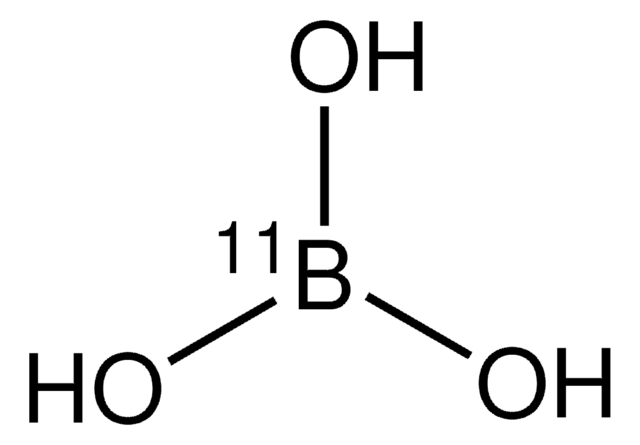Wichtige Dokumente
B0252
Borsäure
ReagentPlus®, ≥99.5%
About This Item
Empfohlene Produkte
Qualität
reagent
Qualitätsniveau
Agentur
suitable for SM 4500 - NH3
suitable for SM 5210
Dampfdruck
2.6 mmHg ( 20 °C)
Produktlinie
ReagentPlus®
Assay
≥99.5%
Form
powder
mp (Schmelzpunkt)
160 °C (dec.) (lit.)
Löslichkeit
water: 40 mg/mL, clear, colorless
Dichte
1.440 g/cm3
SMILES String
OB(O)O
InChI
1S/BH3O3/c2-1(3)4/h2-4H
InChIKey
KGBXLFKZBHKPEV-UHFFFAOYSA-N
Suchen Sie nach ähnlichen Produkten? Aufrufen Leitfaden zum Produktvergleich
Allgemeine Beschreibung
Anwendung
- A catalyst to synthesize poly(δ-valerolactone) via bulk-ring opening polymerization.
- A ligand to synthesize metal-organic frameworks.
- A reagent in the preparation of borate buffer.
- A crosslinker to electrospun dextran nanofibers.
Rechtliche Hinweise
Signalwort
Danger
H-Sätze
Gefahreneinstufungen
Repr. 1B
Lagerklassenschlüssel
6.1D - Non-combustible acute toxic Cat.3 / toxic hazardous materials or hazardous materials causing chronic effects
WGK
WGK 1
Flammpunkt (°F)
Not applicable
Flammpunkt (°C)
Not applicable
Zulassungslistungen
Zulassungslistungen werden hauptsächlich für chemische Produkte erstellt. Für nicht-chemische Produkte können hier nur begrenzte Angaben gemacht werden. Kein Eintrag bedeutet, dass keine der Komponenten gelistet ist. Es liegt in der Verantwortung des Benutzers, die sichere und legale Verwendung des Produkts zu gewährleisten.
EU REACH SVHC Candidate List
EU REACH Annex XVII (Restriction List)
Hier finden Sie alle aktuellen Versionen:
Besitzen Sie dieses Produkt bereits?
In der Dokumentenbibliothek finden Sie die Dokumentation zu den Produkten, die Sie kürzlich erworben haben.
Kunden haben sich ebenfalls angesehen
Unser Team von Wissenschaftlern verfügt über Erfahrung in allen Forschungsbereichen einschließlich Life Science, Materialwissenschaften, chemischer Synthese, Chromatographie, Analytik und vielen mehr..
Setzen Sie sich mit dem technischen Dienst in Verbindung.



